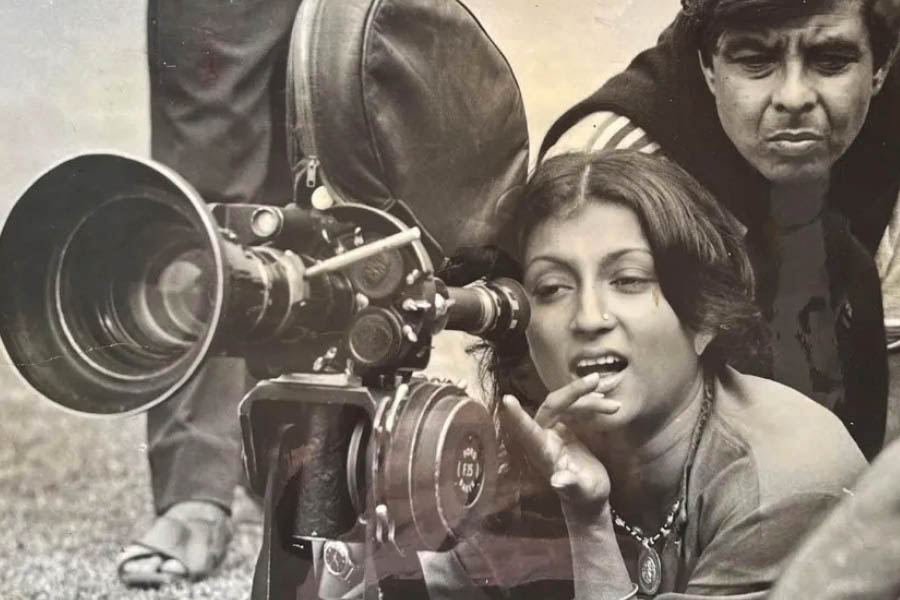Over 40 years later, it remains one of Indian cinema’s most iconic sequences: a black-and-yellow cab drops its passenger at the gate of the Victoria Memorial in the dead of night. An elderly woman walks across the road with a tired gait. A stray dog crosses the frame. A little later, the woman will share the Christmas cake she had made for her young friends, who no longer have any use for her, with the dog.
Violet Stoneham, who teaches Shakespeare to students who have little interest in the Bard, now recites the lines from King Lear, ‘Pray do not mock me’, in what is probably the most profound elegy for a city, a lost way of life. Exactly 20 years after debuting as an actor in Satyajit Ray’s Teen Kanya (the Samapti segment), Aparna Sen’s maiden directorial venture, 36 Chowringhee Lane, wowed audiences and critics alike in 1981.
No wonder then that Suman Ghosh’s documentary on the filmmaker, Parama: A Journey with Aparna Sen, begins with this film and this sequence. It also provides Suman the framework to structure his film: visiting the locations of some of Aparna’s iconic works, for example, Paromitar Ek Din and Goynar Baksho, to ‘relieve the experience’. Suman ushers Aparna to the location of 36 Chowringhee Lane with the words, ‘Ei je tomar bikhyato seedi’ (Here you go, your famous staircase) – as decrepit today as it was in 1981 – and it is a nostalgist’s delight to have Suman intercut the opening sequence of 36 Chowringhee Lane, Ms Stoneham coming across the ‘Out of Order’ lift and trudging her way up, with Aparna making the same journey 40 years later.
It works wonderfully, creating a vibrant and intimate portrait of one of our finest filmmakers. The rapport between Suman and his subject, developed over numerous addas as Suman mentions, comes through right at the outset, as he cuts the opening sequence of his film (the closing sequence of 36 Chowringhee Lane) with a question to Aparna about a letter from Jennifer Kendal (who played Violet Stoneham) where the actor addresses Aparna by her nickname ‘Rina’. Which had led the filmmaker to think aloud to Suman: ‘Sometimes I wonder who this Rina is.’
Aparna’s answer to this – ‘there’s a procession of Rinas behind me… if you think of it in terms of a shot, you are panning across those Rinas until they merge with me’ – sets off the film and its journey perfectly. By the time the end credits roll, you get as much of a sense of the many Rinas that make Aparna Sen as it is possible over an 80-minute film: actor, filmmaker, mother, editor, political activist and so much more.
An actor with a flair for the comic
Immediately after the opening sequences, Suman introduces us to the actor in Aparna with the scene from Samapti where Mrinmoyee bursts into the room looking for Chorki, even as the groom and his party go into paroxysms of coughing. Looking at her filmography as an actor, it is clear – and the film subtly makes that point too – that the directors of the 1960s and ’70s did not know what to make of the actor in Aparna Sen.
Here was someone with a flair for the comic, as evidenced in parts of Samapti, in Baksa Badal and Basanta Bilap (who can forget Aami Miss Calcutta 1976?), but equally at ease with the dramatic in the regretfully few opportunities she got in films like Akash Kusum, Aparachita, Jivan Saikate, or even in cameos in the couple of other Ray films, and those of James Ivory-Ismail Merchant she was a part of.
But no filmmaker had the vision to tap into these aspects. For the most part, she had to make do with scripts that just needed her to ‘be coy, look shy and raise my eyes’, as Aparna admits. A lesser actor would probably have made it work and become a star. However, Aparna was very much a thinking person’s actor, which is probably why she made a shift to making films, the kind of films she was comfortable with, the kind of work that resonated with someone of her intelligence and world view. Maybe that is why we find a bit of her in the brilliant protagonists she has created, as Suman observes.
Revisiting the locations of her films
Her career as an actor obviously does not resonate very well with, say, someone like Anjan Dutt, who is quite frank in saying that he does not like the bulk of her acting! A viewpoint that Goutam Ghose shares. That’s a sentiment that Aparna echoes herself, as is evident in the wonderful exchange with her that Suman narrates. When Suman had approached her for the leading role in Basu Paribar opposite Soumitra Chatterjee, Aparna had said, ‘You have worked with Konkona (in Kadambari); I am not as good an actor as she is.’ To which Suman deadpans, ‘I agree, I know that’, as he narrates this to Konkona.
Konkona Sensharma positions her mother’s career as an actor against the backdrop of films and filmmaking styles of the 1970s. Aparna herself talks at length of the compulsions of keeping the home fires burning that went behind the kind of roles she chose. It says something about her craft as a filmmaker that it was only in her own films, like Paromitar Ek Din, that we get glimpses of what Aparna was capable of as an actor.
The best parts of Parama: A Journey with Aparna Sen have to do with Aparna revisiting the locations of her films. Suman masterfully uses Violet Stoneham’s voiceover ‘I never thought I would want to leave the land of my birth’ as Aparna walks across the rooms of what was 36 Chowringhee Lane, wistfully looks out of the windows, intercut with sequences from the film. Aparna admits to being ‘in a trance’ at the time – ‘Ghorer moddhe chhilam’ as she puts it. As her daughter Kamalini says, ‘She was fully consumed.’ The travails of shooting with a cat, Sir Toby, and Satyajit Ray’s comment about getting a cat to act make for some wonderful insights to the process of filmmaking.
Suman delves into her career in theatre with giants like Utpal Dutt which informed her relationships with the actors she cast in her films. Shabana Azmi recounts a difference of approach that made it almost impossible for her to execute what was required of her in Sati. As Shabana recalls, while she thought of her character in the film as a bull, Aparna thought of Uma as a fox. No two animals could be more different. Aparna allowed Shabana to shoot a sequence as she saw it, and then do it the way the director envisioned it, and Shabana admits that that made all the difference. Rituparna Sengupta, who had one of the best performances of her career in Paromitar Ek Din, points out how observant the director was about a woman’s gait after she has just birthed a child.
Not just an actor and a filmmaker
Parama: A Journey with Aparna Sen, however, is not just about the actor and the filmmaker. Daughters Kamalini and Konkona talk about the mother, while Kalyan Ray describes the ‘repose in Rina’s face, a melancholy, something inward-looking… a solitude’, existing in sharp contrast to her otherwise gregarious nature, that in his view lies at the core of Aparna the artist. Suman also brings in Aparna Sen’s memorable foray into the world of journalism as the editor of Sananda which revolutionised the world of magazines in Bengal, fearlessly addressing hitherto taboo subjects like abortion and family planning, divorce and extramarital affairs, while also including fashion, beauty and cookery. It was a magazine like no other, defining for many the aspects of ‘feminism’ that is so intrinsically part of her films as director.
Suman does not shy away from Aparna’s involvement in the political debates of the day. With her evolution as a filmmaker addressing relationship issues to a more political one (most strikingly from Mr and Mrs Iyer onwards), Aparna has also been fearlessly vocal about her politics (she aligns with left liberalism, as she puts it). Suman makes the very pertinent point of asking Aparna whether hers is just a facile ‘politics of protest’. While the jury may be out on that, and Aparna calmly and cogently articulates her stand, it is refreshing to have someone with her candour in the film and entertainment business.
(Shantanu Ray Chaudhuri is a film and music buff, editor, publisher, film critic and writer)










